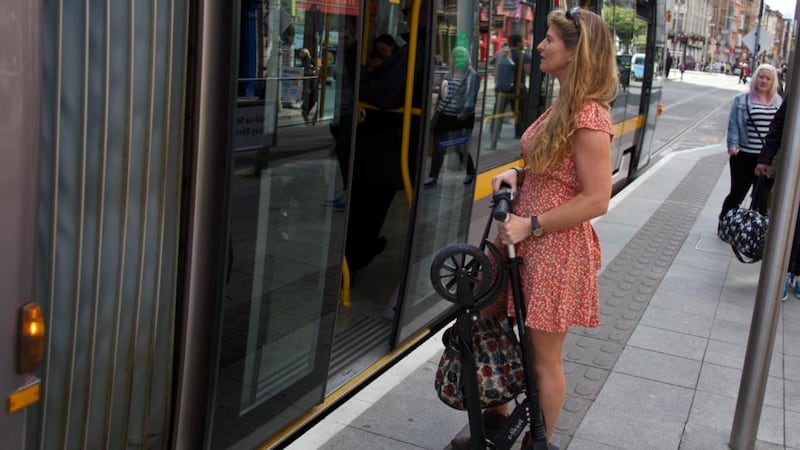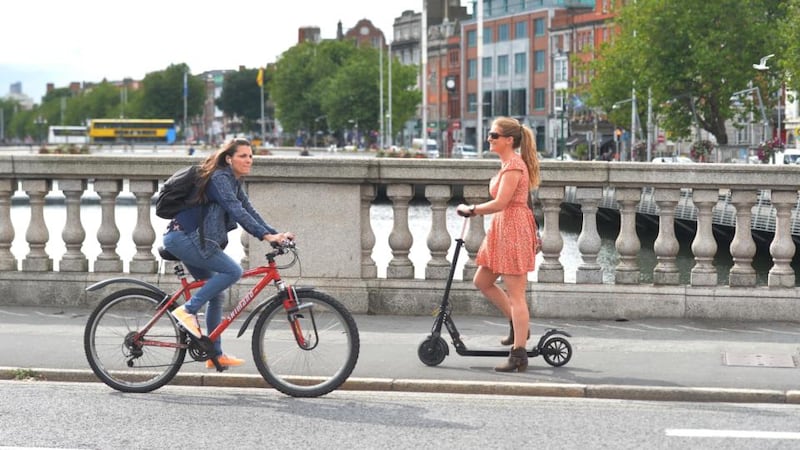When I was asked to review a battery-powered electric scooter for my commute, I had visions of wind in my hair on a Vespa humming up the N11. Not entirely realistic: even less so when I heard my top speeds would be 25km/hr and a maximum range of 35km between recharges.
It turns out the E-Skoot is an electric stand-on scooter – think back to your childhood or look towards the school gates. It's that type of scooter.
Unsurprisingly, it is not envisaged to be used on long commutes, but to be a solution for the first and last 4km of a commute, according to Irish company E-Skoot. It is, they say, “specifically designed to meet the changing needs of the commuter” and saves the extra time spent walking from homes and offices to public transport.


And it can fold up and be brought on the bus or train. It is incredibly cheap to run – the Irish stockists reckon the battery can be kept charged for €1 per year and it plugs into a conventional socket.
I tried it on a few trips to see how it fared.
Day 1
6am: Train from Arklow 7am: How long does it take to get from my house at 25km/hr? Too long it seems because suddenly it’s 6.43am, so I grab the car keys, heave the scooter into the back seat of my VW Golf and leg it.
On the train, the scooter doesn’t quite fit under the seat so I tuck it the carriage standing area, lying alongside the seat. Bemused looks but approval from the Irish Rail conductor.
To make up for my lack of scooting, I disembark at Grand Canal, two stops early and 1.9km from the office. I unfold the scooter and kick off on the footpath. Though battery-powered, you need to push off with your foot and then push the accelerator thumb control to get going. The brake is another thumb control off the right handlebar – more like a bicycle gear lever than where you might expect it. There’s also an option of pressing on the back mudguard to stop either.
After a slightly jumpy start, it’s all going well until everyone else heading for work gets in the way. It’s easy to negotiate the around people at a slow, steady pace – even with both feet on the scooter – but who wants slow and steady on a scooter? So, I cross the road and hit the cycle lane. This is more like it and I quickly get up to about 18km/h (to many more bemused looks and finger pointing) travelling smoothly, aside from an unsettling drop into a dipped manhole cover.
Of course, the cycle lane ends prematurely, meaning I am now on the road. On a scooter. Despite my relative speed, I definitely feel like I am on the road with little protection from the traffic. It’s a feeling familiar to most cyclists but this felt more exposed and a passing Dublin Bus causes me to wobble hard. Note to self – wear a helmet.
The fun really begins in the office where top speeds of 14km/h are reached by wannabe children who line up to try out the new toy. Reviews are all positive – I felt like the lucky schoolkid and, yes, I let them all play. Folded, the scooter sits under the desk. Without any way to lock it, bringing it into the office is a must.
Day 2
This time I do scoot to the train station, 3.2km away. Despite two hills, making progress a little slower than I expect (the E-Skoot has enough power to travel up a 25 per cent incline), I make it in less than half of the time it would take me to walk – 13 minutes compared to 30. Two speed ramps are a little too high for the battery pack, which sits underneath the base but it’s a great way to start the day. Carrying an extra bag wasn’t the best plan because hanging anything off the handlebars throws your balance, so unless you are carrying it on your back or around you, travel light.
At Tara Street Station in Dublin, faced with two flights of steep steps carrying the 10.7kg folded scooter isn’t as easy as I had anticipated. On my return trip, my commuter train has luggage racks and the scooter fits in easily. That night it was tested on country roads and stone surfaces and stands up to the terrain better than I thought it would. I get my top speed of 23km/h. It feels comfortable and is great fun, but using it when you aren’t commuting does make you feel a little lazy. On an after-dark spin, the light in front requires a manual turn-on and I feel pretty invisible from the back.
Day 3
After parking in Ranelagh, south Dublin, I scoot into work. The 2.8km trip usually takes 12-14 minutes by bike, depending on the lights. On the E-Skoot, I make it in 10 minutes. Later, I head for the Luas back to Ranelagh. Folded up, I roll it on board and lean on as I stand for the three-stop journey. Easy peasy.
Verdict
According to Revenue, the E-Skoot does not qualify for the cycle-to-work scheme because you cannot do just that – cycle. The scheme allows for electric bikes but without pedals, the scooter doesn’t fit the criteria.
Whether it is a bike for the purposes of the new cyclist fines is less clear.
I ask four gardaí – two as I pass them on the footpath – and they all said scooting on the footpath would require “due care and attention” for other passersby. What about the €40 for breaking the lights? Technically you aren’t cycling. It seems the legislation hasn’t kept pace with new modes of transport, so it’s a winner for now.
At €700-€1,100 (including taxes) depending on the model, it is the same price as a decent road bike. It is cheap to run, easy to use, can be brought on public transport and is great fun. I definitely felt like I was back in the heady days of childhood and though it was far from Mondello test days of pre-(economic) crash, it was the most fun I have had commuting.
If I had a shorter journey with fewer station steps, it might be just the ticket. But without the cycle-to-work scheme leg-up and the option of taking her for a spin on country roads at the weekend away from the city pollution, I will stick to my two bigger wheels.
The lowdown: E-Skoot
Price: €700-€1,100 (depending on the battery)
Weight: 10.7kg
Range: 35km
Recharge time: 2.5-3.5hrs
Max slope: 25 per cent gradient
Does it qualify for cycle- to-work scheme? No
Terence Cosgrave blogs about the E-Skoot at liversalts.com












